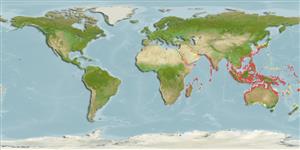Common names from other countries
Environment: milieu / climate zone / depth range / distribution range
Écologie
marin récifal; profondeur 0 - 25 m (Ref. 37816), usually 0 - 25 m (Ref. 37816). Tropical
Indo-West Pacific: Red Sea and East Africa to Fiji, north to southern Japan, south to Australia.
Taille / Poids / Âge
Maturity: Lm ? range ? - ? cm
Max length : 17.0 cm TL mâle / non sexé; (Ref. 5463)
Description synthétique
Clés d'identification | Morphologie | Morphométrie
Épines dorsales (Total) : 5; Rayons mous dorsaux (Total) : 17 - 22; Épines anales: 0; Rayons mous anaux: 17 - 22; Vertèbres: 32 - 33. Color variable (from brown to pink or yellow) with small black and white spots; 2 elongate black spots between first 3 dorsal spines (Ref. 4263). Total body plates 27-35. Caudal fin truncate, rounded, or lanceolate. Caudal peduncle short or lost in large females (Ref. 48635). Pelvic fin sexually dimorphic, forming a brood pouch in females (Ref. 9829).
This uncommon species is found in coastal reefs and weedy areas (Ref. 5463) or lagoon reefs, often on algal flats or seagrass beds (Ref 90102). Monogamous, always in pairs (Ref. 52884). Females carry the eggs in their pelvic fins that are modified to form a brood pouch (Ref. 205). Feed on small crustaceans (Ref. 1602).
Life cycle and mating behavior
Maturities | Reproduction | Spawnings | Egg(s) | Fecundities | Larves
Monogamous mating is observed as both obligate and genetic (Ref. 52884).
Orr, J.W. and R.A. Fritzsche, 1993. Revision of the ghost pipefishes, family Solenostomidae (Teleostei: Syngnathoidei). Copeia 1993(1):168-182. (Ref. 9829)
Statut dans la liste rouge de l'IUCN (Ref. 130435)
CITES (Ref. 128078)
Not Evaluated
Menace pour l'homme
Harmless
Utilisations par l'homme
Pêcheries: sans intérêt; Aquarium: Aquariums publics
Outils
Articles particuliers
Télécharger en XML
Sources Internet
Estimates based on models
Preferred temperature (Ref.
115969): 22.1 - 29, mean 27.8 (based on 1498 cells).
Phylogenetic diversity index (Ref.
82804): PD
50 = 0.5312 [Uniqueness, from 0.5 = low to 2.0 = high].
Bayesian length-weight: a=0.01000 (0.00244 - 0.04107), b=3.04 (2.81 - 3.27), in cm Total Length, based on all LWR estimates for this body shape (Ref.
93245).
Niveau trophique (Ref.
69278): 3.8 ±0.50 se; based on food items.
Fishing Vulnerability (Ref.
59153): Low vulnerability (10 of 100).
